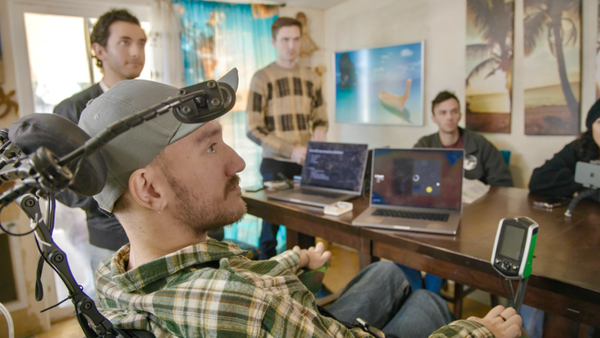Reality of BCI Tech and Market | 매거진에 참여하세요
Reality of BCI Tech and Market
#BCI #Brainwaves #NeuralSign #MachineLea #BrainCompu
Can You Really Control Machines with Your Brain. The Future Is Now: Brain-Controlled Interfaces Are Real
In 2023, a research team in Lausanne, Switzerland made headlines.
They helped a 40-year-old man—paralyzed from a biking accident—walk again using a wireless brain-spine interface.
How? The system detected his intention to walk in real time, translated it into electrical impulses, and stimulated his spinal cord to move his legs. That’s not science fiction. That’s Brain-Computer Interface (BCI) technology—already transforming lives.
And it’s no longer just for labs or sci-fi movies.
What Is BCI, Really?
BCI (Brain-Computer Interface) is a technology that allows direct communication between the brain and an external device.
It reads brain signals—like “I want to move my hand”—and translates them into commands for computers, robotic arms, or even VR worlds.

The Market Is Catching On
According to Grand View Research, the BCI market was valued at $2 billion in 2023 and is projected to grow at a CAGR of 17.8% through 2030.
Even Elon Musk’s Neuralink recently filed trademarks for “Telepathy” and “Telekinesis”—hinting at future platforms for brain-to-brain communication.
How Does BCI Work?
Let’s break it down step-by-step—from brain signal to machine control.

1. EEG – Measuring Brain Activity
Electroencephalography (EEG) is the most common, non-invasive way to read brain signals.
Measures electrical signals on the scalp
- Detects thoughts, focus, emotions, or even sleep states
- Examples: OpenBCI, Muse, Emotiv
- Use cases:
Focus tracking (e.g. brighten screen when focused)
Emotional state detection (stress vs. calm)
Thought-based machine control (e.g. “move cursor left”)
2. EMG – Detecting Muscle Intentions
Electromyography (EMG) tracks electrical activity in muscles.
Even if you don’t move, the intention to move creates EMG signals.
- Use cases:
Control prosthetic limbs
Detect facial or finger movements
Trigger devices without actual motion
3. ECG – Heart as a Brain Mirror
Electrocardiography (ECG) measures heartbeat variations, which often reflect emotional or mental states.
- Use cases:
Real-time stress detection
Emotion-responsive UX (calm = blue interface, stress = red)
Feedback tool for meditation or neurofeedback
The Full BCI Pipeline: From Brainwaves to Action
Here’s how raw thoughts become real-world commands:
Step 1: Signal Acquisition
Brain neurons emit tiny electrical pulses. EEG sensors pick these up via electrodes on the scalp.
Non-invasive: OpenBCI, Muse
Invasive: Electrodes implanted directly into the brain (Neuralink)
Step 2: Preprocessing
Raw EEG data is noisy. You filter out unwanted artifacts—like 60Hz electrical noise or eye blinks.
Use band-pass filters to isolate useful frequencies
Normalize signals for analysis
Step 3: Feature Extraction
You analyze signal patterns or frequency bands:
- Alpha waves: relaxation (8–13 Hz)
- Beta waves: focus and alertness (13–30 Hz)
- Delta/theta: deep sleep or meditative states
You might calculate average amplitudes, peak frequencies, or wave ratios.
Step 4: Classification (via Machine Learning)
Machine learning algorithms detect what kind of “thought” is behind the signal.
Examples:
- SVM (Support Vector Machines)
- Random Forests
- Neural Networks (CNN, LSTM)
These models classify whether you're thinking “click,” “scroll,” “stop,” etc.
Step 5: Execute the Command
Once classified, the system translates the thought into action:
- Move a cursor
- Click a button
- Fly a drone
- Scroll a web page
- Type with your mind
A Simple Example: “Click with My Mind”
Let’s simulate how a BCI system might interpret your intent to click a button.
You think: “Click the button.”
EEG sensors detect rising beta waves in your motor cortex.
Preprocessing removes noise from the signal.
Feature extraction detects beta amplitude > 50μV.
A trained SVM model recognizes this pattern as a “click.”
The system sends a command to your browser to simulate a mouse click via Python or JavaScript.
Magic? No. Just neuroscience + code.
Is BCI Ready for the Real World?
✅ Advantages:
Non-invasive options are improving fast
Works with open-source tools (OpenBCI + Python SDKs)
Machine learning makes signal recognition more accurate
Applications in accessibility, healthcare, gaming, and mental wellness
⚠️ Challenges:
EEG signals are weak and noisy
Individual differences make training difficult
Wearables still lack design comfort and stability
Real-world deployment requires regulatory approvals
But with each passing year, the line between science fiction and science fact is fading.
Final Thought: The Brain Is the Next Input Device
Keyboards, touchscreens, voice—all familiar. But brainwaves? That’s the next frontier.
Whether it's helping someone walk again, controlling a drone with your mind, or simply focusing better through neurofeedback,
BCI is not just an experiment anymore.
It’s becoming a platform.
So the next time someone says “mind control” — remember: it's real, and it’s programmable.






